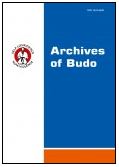2021, Volume 17
Zen and martial arts in Shaolin kung fu
Youkuan Shi1
1 School of Physical Education and Sport, Henan University , Kaifeng, China
Author for correspondence: Youkuan Shi; School of Physical Education and Sport, Henan University , Kaifeng, China; email: shiyoukuan@henu.edu.cn
Full text
Abstract
Since the time of Huineng, the cognitive change marked by the emergence of Zen Buddhism—summed up in the idea that ‘Zen is free from forms, and the path to Buddhahood is inseparable from daily affairs’—has paved the way for monks to practise martial arts in theory and thought. In Zen ideology and discourse system, martial artists are Zen fighters with an active body and a tranquil mind, who integrate dynamic and static states, combine emptiness and existence, and enter non-duality. Zen’s concept of emptiness requires those who practise martial arts to have a broad mind, which can accommodate all objects and phenomena, so that one can use martial arts flexibly, which enables one to come and go freely. Zen Buddhism explores ‘epiphany’ in its methodology, but ‘there is no gradual enlightenment, while knowledge can be gained quickly or slowly’. The so-called sudden or gradual are merely labels and phenomena, however. When learning and practising Shaolin kung fu, one should not adhere to ideas of epiphany or gradual enlightenment, the suitability of which varies from person to person, but rather endeavour solely to not cling to concepts and objects, and just be.
Key words: Buddhahood, Buddhism, enlightenment, epiphany, self-discipline




